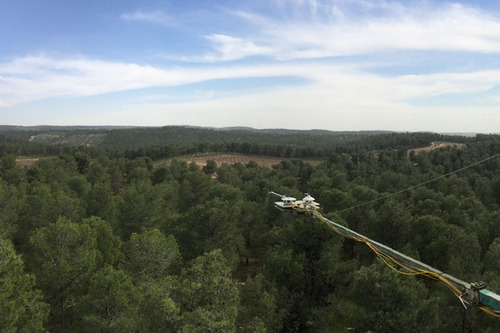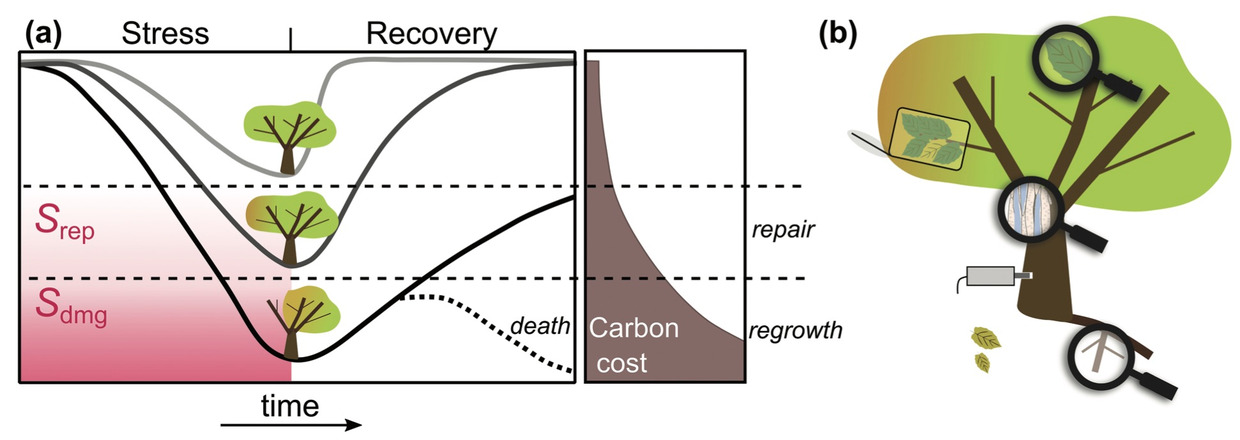Sensing of drought-related tree death
As a consequence of climate change, the frequency of summer drought events is increasing worldwide. The combination of drought stress and high temperatures can cause lethal damage to trees. The dry summers in 2018 and 2019 have severely affected forests in large parts of Central Europe, and many million trees died, causing large financial losses to forest owners. To better understand the impacts of these extreme events on forests in Germany and Central Europe, we want to combine hyper-spectral satellite information with high-resolution imagery and forest monitoring data. This combined dataset will then be used to further investigate the environmental drivers that affect the spatial pattern of stress-induced forest damage. A refined spatial understanding of damage occurrence in relation to environmental factors is a prerequisite for model development and predictive analysis of forest health. This project is funded by the KIT Center for Disaster Management and Risk Reduction Technology.

Ecosystem water fluxes in a changing climate
The interdisciplinary BioWaWi project (Biodiversity and water management) is funded by BMBF (Bundesministerium für Bildung und Forschung). It aims to develop strategies for municipal water management that support biodiversity and ecosystem services. Our specific research within the project addresses water use and groundwater supply in representative ecosystems, and vulnerability of these ecosystems to changes in climate and water management. The LandscapeDNDC model will be initialized for different ecosystems within selected catchments, and site-specific water fluxes will be calculated for current and projected future climates. A specific objective is to evaluate how the performance and vulnerability of dominant tree species may change and how water and forest management could be adapted to meet ecosystem water demands. Contact persons in the Plant Ecophysiology group are Nadine Ruehr and Ruediger Grote.
Forest resilience to climate change: From plant physiology to ecosystem dynamics
Extreme droughts combined with heatwaves are intensifying in frequency and severity world-wide. The impacts on tree and forest functioning are manifold, including tree dieback, and reduced forest health as observed in many regions world-wide with clear consequences for the well-documented contemporary carbon dioxide sink of forests. Yet to date, we lack means to quantify long-term impacts on forest resilience and productivity beyond specific individual drought events. A striking knowledge-gap persists on what determines tree recovery and survival following drought release, including the thresholds causing functional damage and the role of repair mechanisms. To tackle this challenge, we integrate experimentally-derived tree physiological understanding of recovery responses and stress legacy into process-based modelling. Large added-value to the modelling will be provided by combining and analysing observation-based data that cover different spatial and temporal scales using artificial intelligence algorithms. In the experimental work, short- and long-term recovery dynamics of photosynthesis, water relations, carbon metabolism and growth of European tree species will be studied including potential acclimation mechanisms. The combination of modelling, experimental studies and observational data allow for a major breakthrough in our understanding of drought legacy in forested ecosystems, and provide a scientific-base to assess and guide the resilience of European forests to climatic extremes.
How is Climate Change affecting the development of forests?
We are contributing to the Special Research Area ‘ECOSENSE’, led by the University of Freiburg (https://ecosense.uni-freiburg.de/) with model simulations using the LandscapeDNDC model (https://ldndc.imk-ifu.kit.edu/about/model.php). The simulations are covering energy, carbon, and water fluxes within a mature mixed stand in the Black Forest, featuring Douglas fir (Pseudotsuga menziesii), Silver fir (Abies alba), and European beech (Fagus sylvatica). On the one hand the physiological processes of the model will be evaluated and further developed based on numerous measurements, on the other hand the simulations will serve to optimize sensor distribution and machine learning techniques. The subproject is jointly carried out with the IFU working group ‘Ecosystem Matter Fluxes’ of Ralf Kiese (https://bgc.imk-ifu.kit.edu/ecosystem-matter-fluxes).
Decision support for planting and tending urban trees
In order to ensure that urban trees can develop their beneficial effects even in times of increasing heat and drought, suitable species should be selected and, if necessary, measures should be taken to protect them in good time. Therefore, various research groups from KIT and the University of Freiburg are jointly working on the project ‘Future-Oriented Climate Change Management for Urban Green Spaces’ (ZUKAMAS) are trying to find out more about the sensitivities of trees. How much do trees suffer from urban heat? Can they cool themselves? What happens if there is also a lack of water? To answer these questions, climatic and physiological measurements are carried out and evaluated using tree models. This project is funded by the Science ministry of Baden-Wuerttemberg from the program ‘Innovationcampus Sustainability’.
Past projects
Climate benefits and feedbacks of semi-arid forests

In this joined DFG-funded project (2015-2019) with colleagues from the Weizmann Institute, we quantified responses of Aleppo pine trees to future, increasingly extreme conditions as predicted for the Negev region, where the Yatir forest, a large Aleppo pine plantation is growing. We focused on how the trees cope with heat waves and drought today and in the future under increased atmospheric carbon dioxide concentrations. We measured whole-tree gas exchange, emissions of volatile organic compounds and metabolites under controlled conditions. We found that heat and drought combined can kill seedlings due to overheating (Birami et al. 2018) and that dying seedlings could be identified at their unique VOC fingerprint (Birami et al. 2021). Further, we found no clear indications that elevated CO2 would mitigate hot drought stress responses in Aleppo pine seedlings (Birami et al 2020; Gattmann et al. 2020).
Stress-induced BVOC emissions

Biogenic volatile organic compounds (BVOCs) are emitted from plants and can be highly reactive altering atmospheric chemistry and air quality. In this Georg-Forster fellowship from the Humboldt Foundation to Dr. Elizabeth Gaona (2019-2021), emissions of volatile organic compounds from trees under heat and drought stress were investigated. In addition, the atmospheric oxidation of stress-related BVOC emissions was quantified in a cooperation with colleagues from the Forschungszentrum Juelich using the Saphir-PLUS chamber.
Forests out of balance
The main focus of the DFG-funded Emmy Noether research group is to provide a detailed process understanding of carbon and water cycling in trees and forests exposed to varying stress scenarios, intensities and timing of stress. The main study object, Scots pine, one of the most widespread trees within Europe, has already shown significant decline in response to extreme drought events. We are particular interested in the underlying physiological responses including tree hydraulics, gas exchange, carbon allocation and growth during heat and drought stress and the ability to recover from stress. Based on experimental results and ecosystem observations we will improve a model framework (LandscapeDNDC) to assess pine forest responses to future climate extremes.

Ecosystem services of urban trees
We aim to evaluate microclimate and air pollution mitigation effects of urban trees in Karlsruhe, Germany under current and future climate conditions. A newly developed physiology-based model will be applied which consider drought impacts on vegetation cooling as well as pollutant uptake by the plants. The work will potentially include the impact of more than 100.000 trees in Karlsruhe and surroundings and contributes to decision support about where, how many, and what species should be planted. This is a sub-project of the BMBF-funded research project Gruene Lunge. Contact persons in the Plant Ecophysiology group are Nadine Ruehr and Ruediger Grote.

.svg)
